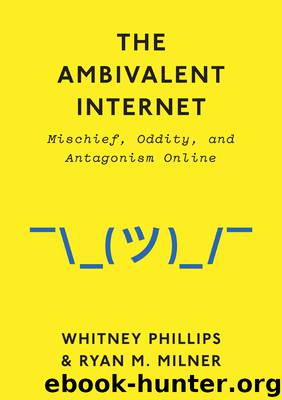The Ambivalent Internet by Whitney Phillips & Ryan M. Milner

Author:Whitney Phillips & Ryan M. Milner
Language: eng
Format: epub
Publisher: Wiley
Published: 2017-06-02T04:00:00+00:00
The top right-hand image in Figure 6 also represents uniquely digital play. It was created by Imgur user GuyGoald (2016), who edited scenes from the 2015 film Star Wars: The Force Awakens into a GIF set featuring characters fighting with, oogling, and scrambling to recover pieces of garlic bread, yielding a remix called, fittingly, “The Garlic Awakens.” Visually, the flimsily photoshopped two-dimensional bread cascading through the big-budget Star Wars universe makes little sense; thematically it's even more absurd. It may be a little more understandable in the context of all the other absurd memetic play surrounding garlic bread, a memetic subgenre resonant enough with enough participants for it to warrant its own entry on meme database Know Your Meme (“Garlic Bread” 2016). But, of course, the memetic resonance of garlic bread just raises its own set questions – most notably, “wait, what?” and “but why?” What really makes garlic bread (or anything) funny is as inscrutable now as it ever has been. What is different is GuyGoald's individual ability to amplify a resonant meme, and to do so by so thoroughly altering an apparently static media text.
The bottom right-hand image presents even more memetic vernacular creativity. It's one of scores of unflattering stills of Dana Scully from The X-Files shared on Tumblr, many of which use the GIF format to overlay her trademark red hair with shimmering sparkles. The thematic recurrence of unflattering Scully images is afforded by image capturing tools that allow participants to go through X-Files episodes frame by frame and immortally fix momentary facial contortions. The visual addition of shimmering sparkle hair amplifies the juxtaposition with another layer of unexpected – and uniquely digital – incongruity. The kind of absurdist collective humor illustrated by this image, by all the images featured in this section and in fact this whole book, certainly isn't new or confined to the internet; recall Chapter 1's Peanuts and Looney Tunes sex art. That said, the ease and ubiquity of multimodal reappropriation pushes that humor into hyperdrive online.
In the context of silly photoshops, incongruous image captions, and non sequitur GIFs, the fact that digital media tools facilitate absurdist humor seems like a rosy, or at least a neutral, declaration to make. So people are weird; isn't that funny? Or bemusing, or annoying, or who cares and what's for lunch?, depending on your perspective. But those are not the only contexts in which humor online occurs, and not the only contexts in which digital tools facilitate dizzying memetic absurdity. The fundamental ambivalence of these tools, and just as importantly, the chaos that can be loosed when appropriate incongruity spins out of control, is rendered much clearer when memetic humor is applied to moments of death, pain, and tragedy. In these cases, fetishism grows sharper teeth.
Playful remixes of the terrorist attacks of September 11, 2001, exemplify the flipside of the constitutive coin. Immediately following the attacks, these joking behaviors mirrored traditional “joke cycles,” waves of humor often following high-profile events (see Ellis 2003 and Kuipers 2005 for an overview of initial joking reactions to 9/11).
Download
This site does not store any files on its server. We only index and link to content provided by other sites. Please contact the content providers to delete copyright contents if any and email us, we'll remove relevant links or contents immediately.
Sass and Compass in Action by Wynn Netherland Nathan Weizenbaum Chris Eppstein Brandon Mathis(7837)
Grails in Action by Glen Smith Peter Ledbrook(7772)
Azure Containers Explained by Wesley Haakman & Richard Hooper(6932)
Configuring Windows Server Hybrid Advanced Services Exam Ref AZ-801 by Chris Gill(6927)
Running Windows Containers on AWS by Marcio Morales(6458)
Kotlin in Action by Dmitry Jemerov(5157)
Microsoft 365 Identity and Services Exam Guide MS-100 by Aaron Guilmette(5121)
Microsoft Cybersecurity Architect Exam Ref SC-100 by Dwayne Natwick(4712)
Combating Crime on the Dark Web by Nearchos Nearchou(4694)
Management Strategies for the Cloud Revolution: How Cloud Computing Is Transforming Business and Why You Can't Afford to Be Left Behind by Charles Babcock(4444)
The Ruby Workshop by Akshat Paul Peter Philips Dániel Szabó and Cheyne Wallace(4384)
The Age of Surveillance Capitalism by Shoshana Zuboff(4001)
Python for Security and Networking - Third Edition by José Manuel Ortega(3939)
Learn Wireshark by Lisa Bock(3623)
The Ultimate Docker Container Book by Schenker Gabriel N.;(3604)
Learn Windows PowerShell in a Month of Lunches by Don Jones(3537)
Mastering Python for Networking and Security by José Manuel Ortega(3383)
Mastering Azure Security by Mustafa Toroman and Tom Janetscheck(3372)
Blockchain Basics by Daniel Drescher(3343)
